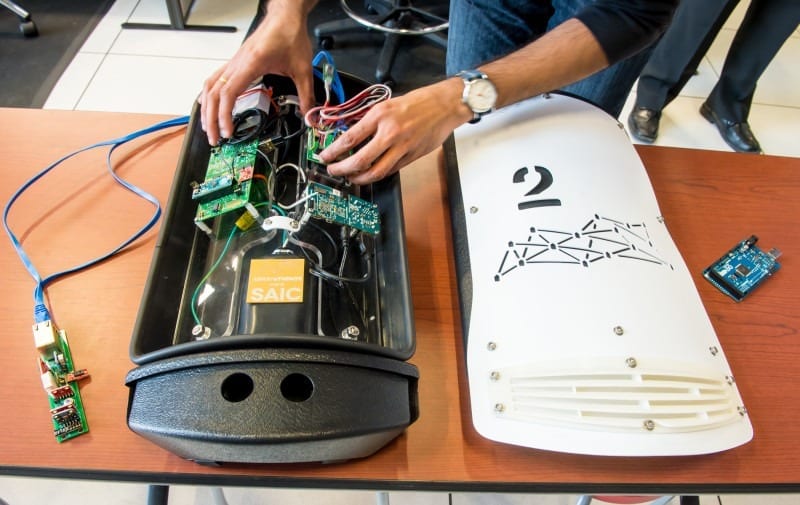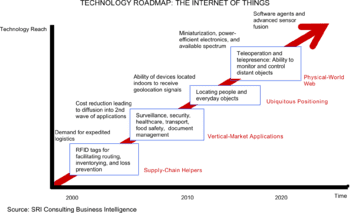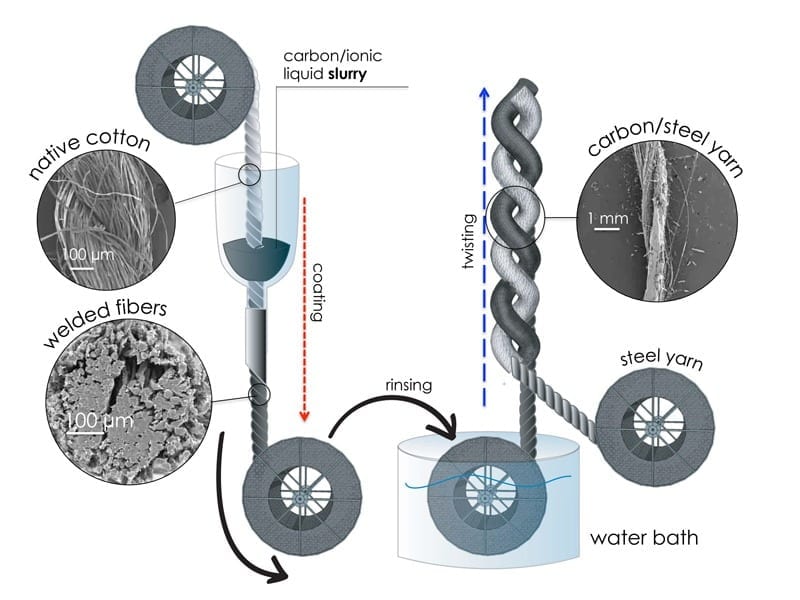
Credit: Mark Lopez
The Array of Things, The Internet of Things, ultimately, “smart” cities have to feature hundreds, maybe thousands, of strategically placed sensors. These devices would record everything from air pressure and temperature to microbial content. The newly developed Waggle platform is the system on a chip that will enable this to happen.
As urban populations increase, so too does the complexity involved in maintaining basic services like clean water and emergency services. But one of the biggest barriers to making cities “smarter” — for example, comprehensively monitoring sources of waterway pollutants in real time — is quick and easy access to data.
Future scenarios like these depend on technology not yet widely available. Future “smart” cities would have to feature hundreds, maybe thousands, of strategically placed sensors. These devices would record everything from air pressure and temperature to microbial content, and the data would be relayed instantly to the laptops of people who can make decisions based on what they are seeing.
Researchers at the U.S. Department of Energy’s Argonne National Laboratory are laying the groundwork for that future now. Their newly developed Waggle platform outfits researchers with a next-generation data collection experience. Featuring the same type of circuit board and real-time processing speeds inside your smartphone, “Wagglers” can add their own mix of sensors, specific to what they’re researching, and install programs onto a single low-power “system on a chip” (SoC) computer board, complete with a Linux-based operating system to control them.
“Waggle can gather the data, send it up to the cloud and get a really fantastic picture of whatever physical processes the researcher wants, whether it’s city or climate data or even hyperspectral data from plants,” said Argonne senior computer scientist and project leader Pete Beckman. “This is the equivalent of a microscope looking at a cell, except we’re using sensors, turning them towards the environment and getting the most comprehensive picture yet of what is actually happening.”
Waggle began as a small project characterizing heat and temperature fluctuations inside a supercomputer’s machine room. Simple devices lined the computer racks, recording and transmitting data from air flow and temperature. Soon, though, researchers realized that what they really needed was a computing platform for sensors to process the data they were receiving.
Once a sensor is placed in its environment, “the data just sits there isolated,” said Argonne materials scientist and 1851 Royal Commission Design Fellow, Jacqueline Cole.” And if anything goes wrong during this period of testing, then you’ve got nothing to come back to. With Waggle, you can monitor the project website, and if something looks kind of screwy you can go in and correct it.”
Another Waggle feature is in-situ processing.
“Waggle includes advanced management features that constantly monitor power use and can be programmed to respond to specific conditions like temperature and light intensity or a data signature from a camera or other sensor,” said Argonne assistant computer scientist Rajesh Sankaran. “Very few people are experts in embedded computer systems, so we’ve provided a framework for writing Waggle code that can run in-situ and have taken the guesswork out of the data-collection process, providing researchers with a way to automatically plug, play and retrieve safe and secure data from the cloud.”
Environmental scientists have begun to take notice and plan to use the Waggle platform to collect their data for future projects.
Read more: Data driven discoveries: Imagine smart cities with thousands of strategically placed sensors
The Latest on: Smart cities
[google_news title=”” keyword=”Smart cities” num_posts=”10″ blurb_length=”0″ show_thumb=”left”]
via Google News
The Latest on: Smart cities
- Smart City to tweak size of Ribandar wharf for fisherfolkon April 30, 2024 at 4:08 pm
Panaji: Imagine Panaji Smart City Development Ltd (IPSCDL) has decided to reduce the length of the fisherman’s wharf proposed at Ribandar from 50 metr.
- Smart Flood-Prone Cityon April 30, 2024 at 1:21 pm
Areas like Boulevard, Dalgate, Karan Nagar, Khayam, Khanyar, Sonwar, Nowhatta, and others have been severely affected, and residents are demanding immediate action from the authorities. The need of ...
- Cash crunch: At least seven smart city projects shelved in Puducherryon April 30, 2024 at 1:06 pm
PUDUCHERRY: In a setback to Puducherry’s urban development aspirations, several initiatives under the Smart City project have been abandoned due to financial co ...
- Rains Inundate Srinagar Areas, Raise Questions On Smart City Planningon April 29, 2024 at 7:51 pm
Srinagar- As heavy rainfall drenched the valley, several areas of Srinagar city, including the iconic Boulevard, have been inundated, prompting conc ...
- ITMAX, JLand in smart cities collaborationon April 29, 2024 at 5:12 pm
ITMAX System Bhd, via its subsidiary Southmax Sdn Bhd, and JLand Group Sdn Bhd (JLG), the real estate arm of Johor Corp, have signed a memorandum of understanding (MoU).
- ITMAX and JLand Group partner to develop smart citieson April 29, 2024 at 3:01 am
ITMAX System Bhd, via its subsidiary Southmax Sdn Bhd, and JLand Group Sdn Bhd (JLG), the real estate arm of Johor Corp (JCorp), have signed a memorandum of understanding (MoU).
- [INTERVIEW] Smart city initiatives, Hangeul promotion take priority in Sejong's policy goals: mayoron April 29, 2024 at 12:55 am
Administrative town seeks more global exchangesSejong was established as an administrative town with the goal of achieving balanced regional development and addressing overcrowding in the metropolitan ...
- Lessons From Abroad: What Does It Take to Be Called A ‘Smart City?’on April 26, 2024 at 3:52 pm
This article originally appeared on Hypepotamus, whose editor, Maija Ehlinger, traveled to Taipei to report on the Smart City Summit and Expo 2024 in March. It is published on Global Atlanta as ...
- Talk Back: If you seek a smart city, keep lookingon April 25, 2024 at 12:07 pm
It’s strictly middle of the pack on the dumb states ranking.
- European and Asian cities dominate latest smart city rankingson April 22, 2024 at 6:39 am
European and Asian Cities Take Lead in Smart City Race, North America Falls Behind. Zurich named world's top smart city ...
via Bing News










